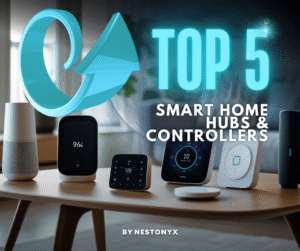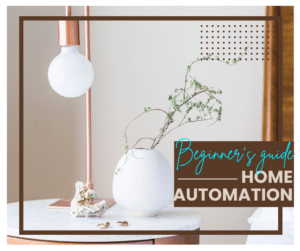As an Amazon Associate, we may earn a commission if you make a purchase — at no extra cost to you.
Smart Home Overkill: Avoiding Automation Burnout
Is your automation more stress than smart? Discover what causes smart home overkill and how to reset your system without starting from zero.
Table of Contents
Ever catch yourself grumbling at your own light switch, or digging for a manual just to get the TV working? Smart home overkill creeps in before you know it—one minute you’re just asking Alexa for a playlist, the next your fridge is texting you about the ice tray. When smart home automation starts causing more hassle than help, maybe it’s time to ask if all these gadgets are really making life smoother.
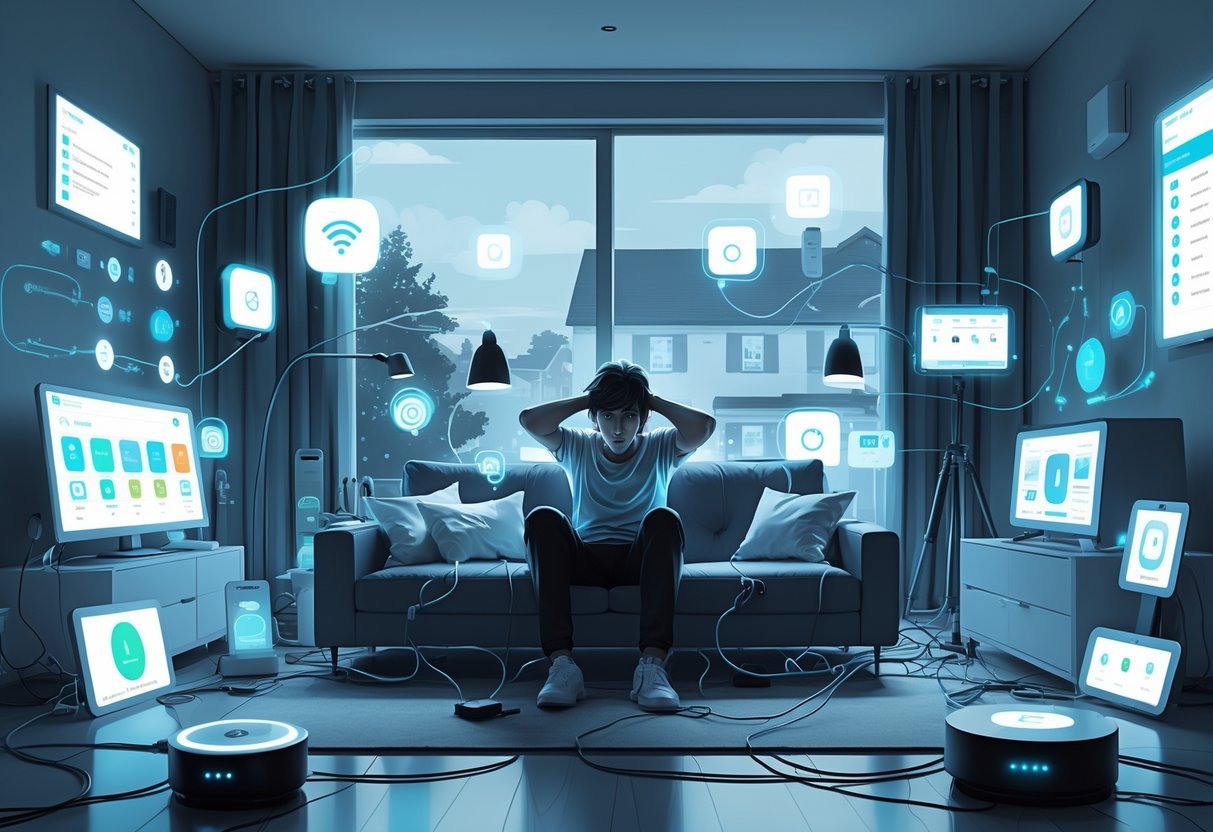
Lots of folks set up these gadgets hoping for convenience, but end up stuck with clunky apps and gizmos that don’t want to cooperate. Lights turn on for no reason, coffee starts brewing at weird hours, and suddenly your day is just troubleshooting one thing after another. Isn’t the point for your home to support your life, not make it more complicated?
You don’t have to toss all your tech, but it’s worth thinking about which devices actually help. Keep it simple, use automation where it counts, and always have a way to do things the old-fashioned way when tech acts up.
Key Takeaways
- Smart home overload is when automation creates extra work instead of saving time.
- Watch out for tech conflicts, too many apps, and routines that just make things confusing.
- Simplifying your setup usually makes for a smarter, less stressful home.
Smart Home Overkill Explained: When Too Much Tech Backfires

Smart home overkill happens when too much smart tech turns convenience into chaos, creating unnecessary frustration. Instead of making things easier, too many gadgets or routines just pile onto your day, causing more problems than they solve.
What Counts as Smart Home Overkill? Key Signs to Know
This happens when automation and smart devices go way past what’s useful. You might see homes packed with smart plugs, bulbs, sensors, and speakers in every corner—just because, well, it’s possible.
At some point, technology starts running the show for things that never needed it. Like, do you really need the closet lights on a schedule, or the blinds moving up and down all day? It’s easy to lose sight of the point: making life better, not busier. When things tip the wrong way, smart home setups can just feel like extra work.
✅ Battery-Operated Motion Sensor Night Light – Simple & Effective
🛠 Product: Beams MB720 20 Lumen Wireless Battery Powered Motion Sensing Nightlight
🧠 Why: Great for readers overwhelmed by smart bulbs and scheduling apps. These lights are intuitive and efficient without Wi-Fi.
- Extremely bright LED Light with minimum power consumption. This little light is mighty bright. Runs…
- Motion sensor turns LED light on and off automatically only when motion is detected. Activates only…
- Weatherproof Design. Can be used as an Indoor Light or an Outdoor Light. UV-Resistant Plastic which…
Last update on 2025-11-12 / Affiliate links / Images from Amazon Product Advertising API
“Rather than scheduling closet lights, try a stick-on motion nightlight that just works.”
Common signs of smart home overkill:
- Way too many apps for basic stuff
- Routines that overlap or just don’t work right
- Needing instructions to turn on a light or answer the door
When Smart Routines Go Too Far: Automation Overload
Automation goes overboard when routines stack up and gadgets start fighting with each other. Maybe two apps try to control the same light, or a scene makes three things happen when you just wanted one. It gets messy fast.
Super-smart homes often rely on constant updates, cloud syncing, and new permissions. When every switch and plug is “smart,” even a small Wi-Fi hiccup can mess up your whole system. Suddenly, keeping it all running is more work than any convenience you get.
Trying to automate every tiny task—like feeding pets, spraying air freshener, or making coffee—can turn your home into a confusing puzzle. When it comes to avoiding smart home overkill, less automation often means more peace of mind.
✅ Manual Coffee Grinder – No Wi-Fi Required
🛠 Product: JavaPresse Manual Coffee Grinder
🧠 Why: A symbolic “return to basics” alternative when automation feels excessive—helps anchor the post’s message. It also appeals to slow-living readers escaping from tech fatigue.
- ENJOY THE PERFECT CUP OF FRESH COFFEE ― The Manual Coffee Grinder by JavaPresse Coffee Company has…
- CONVENIENT, PORTABLE, AND EASY-TO-USE ESPRESSO GRINDER ― The hand crank grinder eliminates 90% of…
- THE BEST WAY TO START YOUR DAY ― This manual coffee bean grinder is equipped with a professional…
Last update on 2025-11-12 / Affiliate links / Images from Amazon Product Advertising API
“Consider switching to a simple manual coffee grinder like this one for a less stressful, more hands-on morning routine.”
How Smart Home Overkill Disrupts Daily Life
Too much automation can make your home stressful instead of comfortable. Instead of easy routines, you get interruptions, gadgets arguing, and missed triggers. Voice assistants might talk over each other, and flipping on a light becomes a weird process.
Comfort goes out the window when routines fail—like heat shutting off in the middle of the night, or smart locks not doing their job. Family members get frustrated when things don’t work, and honestly, it can even get a bit risky. Turns out, connecting everything sometimes just means more digital headaches.
For many, smart home overkill leads to more app-juggling and device troubleshooting than actual convenience or comfort. Too many smart gadgets can lead to smart home overkill—where your tech ends up complicating life instead of improving it.
Automation Overload: Top Signs Your Smart Home’s Too Smart
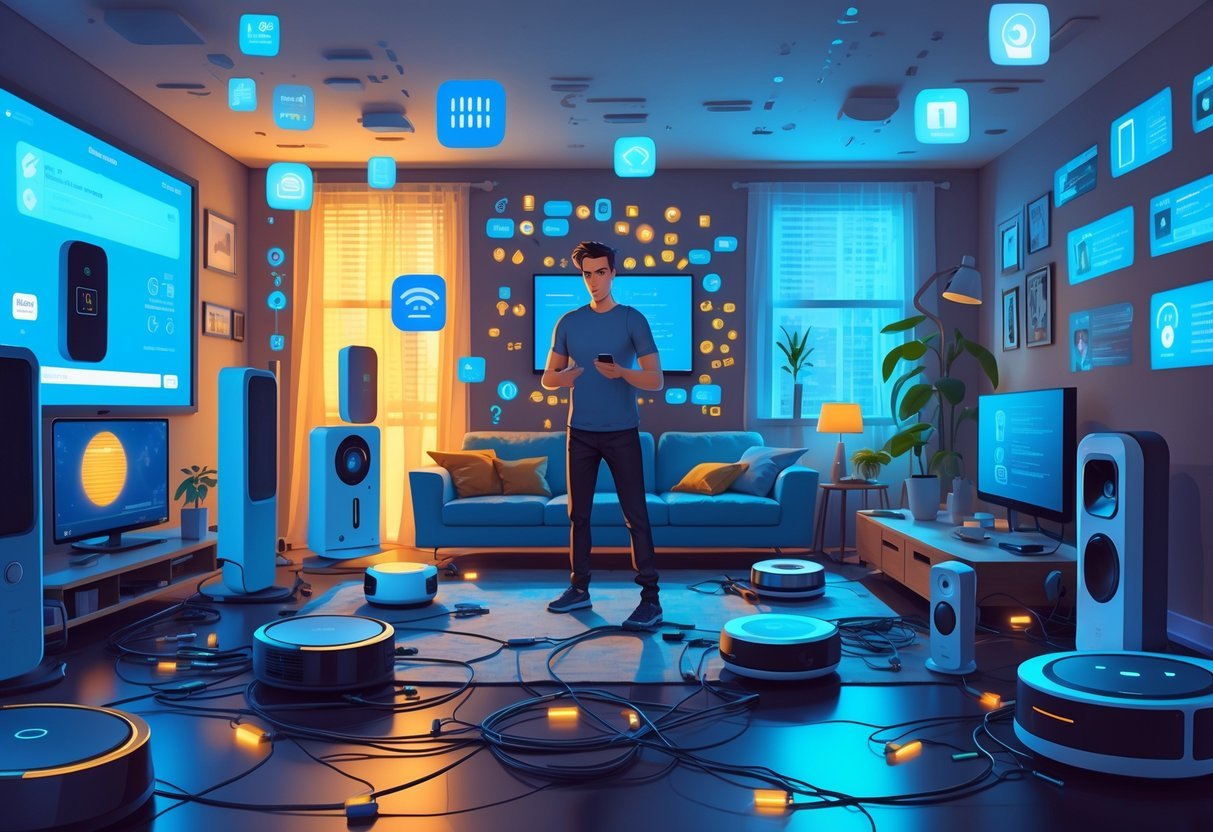
A smart home should simplify your day—but with smart home overkill, things often get harder instead. When tech starts tripping you up every day, that’s a pretty good sign you’ve crossed the line.
Daily Routine Disasters Caused by Smart Home Conflicts
When automations clash, mornings can feel like tech support duty. Maybe the lights flicker, speakers blast music over your alarm, or blinds keep opening and closing for no reason. It’s not exactly the comfort you signed up for.
Stuff like overlapping schedules, triggers that don’t match your real habits, or scenes that go off at the wrong time are all too common. For example, a “Good Morning” routine might run at the same time as a “Weekend” mode, and suddenly both are fighting for control.
Stacking too many routines just leads to interruptions when you need things to work. If your gadgets react to every little thing, life gets unpredictable—and honestly, kind of annoying.
App Fatigue and Alert Overload in Smart Homes
Juggling a bunch of smart devices usually means juggling a bunch of apps. Before you know it, you’re jumping between platforms just to turn on the lights. Every new gadget wants its own app and login, and your phone turns into a maze.
And then there’s the notifications. One for the fridge, another for the door, another for the camera—pretty soon, you’re drowning in alerts. Instead of keeping you informed, it’s just digital noise. Important stuff gets lost in the shuffle.
If you want to keep your sanity, try to get everything on one platform and pick which alerts actually matter. Otherwise, managing your house feels like scrolling through a busy social feed. More on that at Device Overload: Home Sanity Now.
Voice Assistant Clashes: Alexa, Siri, Google & Chaos
Ever have Alexa in the kitchen, Siri in the living room, and Google in the bedroom? It gets weird fast. Commands get mixed up, assistants talk over each other, and sometimes nothing happens at all.
One assistant might pick up a command meant for another, or two might both act at once—double trouble, or nothing at all. Sometimes family members even argue about which system to use. Smart home overkill like this adds stress instead of streamlining daily life.
Most folks find it’s easier to stick with one assistant. That way, everyone’s on the same page and things just work better.
Smart Routine Fails: When Automation Misfires
Misfiring routines are a dead giveaway you’ve got too much automation. If your vacuum starts up during a meeting, or the AC shuts off because the system thinks the room’s empty—even when you’re there—it’s a sign things are too complicated.
Random updates, dead batteries, or missed Wi-Fi connections can make even simple routines fail. The more you stack on, the more likely something goes sideways, especially if you haven’t kept things coordinated.
To keep things running, smart homeowners check on their setups now and then, keep automations simple, and ask if each routine really helps. If you’re curious about common failures, check out Top 7 Smart Home Frequent Issues.
Why “Too Smart” Goes Wrong
Smart home tech falls apart fast if you just install stuff without thinking, skip the maintenance, or keep adding gadgets for no real reason. Suddenly, all those “helpful” devices are just making your day harder.
The Pitfall of Automating Without a Plan
Adding smart devices without a plan? That’s a recipe for chaos. People throw sensors, switches, and routines everywhere because it sounds cool, but forget to ask if they’ll actually use them. Like, maybe you set up a fancy morning routine with lights, music, and coffee, but in reality it just wakes you up at the wrong time or in the wrong order.
What you end up with is a tangled mess of triggers that overlap or just don’t make sense. One routine turns off the lights, another turns them right back on—it’s enough to make anyone frustrated. If you don’t stop to think about what actually needs automation, you’ll probably just make things harder. Honestly, taking the time to plan and personalize your setup is worth it. There’s a good discussion about this in smart homes becoming “too smart”.
Smart Device Maintenance: Updates, Bugs & Battery Drains
Every smart gadget needs a little TLC. Bulbs, locks, sensors, cameras—they all need updates and battery checks. Skip those, and you’ll find things slow down, lose connection, or just plain stop working until you fix them.
Firmware updates have a habit of hitting all at once—usually when you’re busy, like at dinner or during a meeting. It’s annoying, and if you ignore updates, you risk security issues or random malfunctions.
Wi-Fi drops can make gadgets lose sync, which means more troubleshooting for you. Frequent updates and software bugs turn what should be simple tasks into chores. If your smart devices constantly demand attention, that’s smart home overkill working against you.
Too Much Tech, Too Little Benefit: When Smart Gets Silly
Just because you can add the latest gadget doesn’t mean you should. Every new device seems to come with its own app, permissions, and a fresh set of instructions to learn. Bouncing between apps just to control your lights, locks, speakers, or blinds often leads to app fatigue and frustration.
✅ Corded Electric Fan – No App, No Setup
🛠 Product: 3 – Speed Mechanical Knob Air Circulator – Desk Fan
🧠 Why: Many users automate fans unnecessarily via smart plugs. A powerful plug-and-play fan highlights “not everything needs a smart brain.”
- 11.71″ Turbo Airflow for Every Room:11.71″ oversized blades (47% larger than 7.9″ competitors)…
- Quiet Performance for Undisturbed Comfort Product introduction copy: Features NACA technology and…
- Efficient Cooling All Year Round : Pair with heaters, humidifiers, or purifiers to enhance appliance…
Last update on 2025-11-12 / Affiliate links / Images from Amazon Product Advertising API
“Sometimes, going with a reliable corded fan beats syncing one to your voice assistant or app.”
Some so-called features feel more like a gimmick than anything useful. Take syncing your toothbrush with your fridge—who really needs that? It only adds confusion if something goes wrong.
A table comparing essential vs. unnecessary automations:
| Automation | Usefulness |
|---|---|
| Lights (simple timers) | High |
| Security alerts | High |
| Voice-activated coffee | Moderate |
| Toothbrush to fridge sync | Low |
| Automated curtain openers | Moderate |
Pretty quickly, you realize not every appliance or habit needs a smart upgrade. The more devices you add, the messier things get—and too many pointless automations can make your home feel less comfortable, not more.
How to Simplify and Maintain a Smart Home
A smart home should actually make things easier, not pile on more confusion. The best setups stick to useful automation, avoid clutter, and don’t need constant babysitting.
Essential vs Excess: What You Should Actually Automate
Too much automation just creates chaos. It’s better to focus on what’s actually helpful. Start by listing your basic needs—lighting, climate, security, that sort of thing. Each room doesn’t need more than one or two main automations.
🔌 Smart Plugs: Kasa Smart Plug Ultra Mini 15A
- Why it’s great: Compact, reliable, works perfectly with Alexa and Google Assistant. Ideal for small spaces and simple automation without cluttering routines.
- Voice control: Kasa smart plugs that work with Alexa and Google Home Assistant. Enjoy the hands free…
- Easy set up and use: 2.4GHz Wi-Fi connection required. Plug in, open the Kase app, follow the simple…
- Scheduling: Use timer or countdown schedules set your smart plug to automatically turn on and off…
Last update on 2025-11-12 / Affiliate links / Images from Amazon Product Advertising API
Amazon Smart Plug
- Why it’s great: Seamless integration with Alexa makes it ideal for Alexa-centric homes—no extra apps needed.
- Amazon Smart Plug works with Alexa to add voice control to any outlet.
- Simple to set up and use—plug in, open the Alexa app, and get started in minutes.
- Compatible with many lamps, fans, coffee makers, and other household devices with a physical on/off…
Last update on 2025-11-12 / Affiliate links / Images from Amazon Product Advertising API
Get rid of triggers that overlap or aren’t necessary. Stuff like a coffee maker starting with your alarm, or lights shutting off at bedtime, or smart locks re-locking after you come in—those are the kinds of automations that add real value. If something’s more hassle than help, just turn it off.
Unused or buggy features are classic symptoms of smart home overkill—sometimes manual controls are smarter. This way, you avoid smart home overkill and keep things from spiraling out of control.
✅ Analog Light Timer Plug – Simple Automation Without Apps
🛠 Product: Woods 50015WD Indoor Mechanical Timer
🧠 Why: Ideal for users frustrated with apps and cloud-based automations. It offers the same timed-control functionality without a smartphone.
- Heavy Duty Indoor Timer, 3 ON/3 OFF settings per day
- Controls 120V air conditioners
- Controls any heavy-duty load up to 15 Amps
Last update on 2025-11-12 / Affiliate links / Images from Amazon Product Advertising API
“Or skip the Wi-Fi altogether with a mechanical outlet timer like this one, which does the job with zero tech fuss.”
Simplify Your Smart Home: One Ecosystem to Rule Them All
Juggling too many apps or brands can make your smart home a headache. Sticking with one main ecosystem—like Alexa, Google Home, or Apple HomeKit—makes life simpler. It’s worth buying stuff that plays nice with your chosen system, and looking for smart home hubs that tie everything together.
Amazon Echo Hub
- Why it’s great: A single touch panel that unifies control over Alexa-compatible devices, eliminating app-jumping and reducing routine overload. Tested and praised by WIRED and The Verge.
- Echo Hub — An easy-to-use Alexa-enabled control panel for your smart home devices—just ask Alexa…
- Streamline your smart home — Customize the controls and widgets, displayed on your dashboard to…
- Works with thousands of Alexa compatible devices — Compatible with thousands of connected locks,…
Last update on 2025-11-12 / Affiliate links / Images from Amazon Product Advertising API
Try to limit the types of connections (Wi-Fi, Zigbee, Z-Wave) you use. Check compatibility before you buy anything new. Consolidating devices and platforms means fewer headaches and easier routines.
When everything’s in one app, setup and troubleshooting get way less painful. It also makes it easier to share controls with family—no need to train everyone on a bunch of different apps.
Smart Routine Checkups: Keep Your Automation Healthy
Smart homes need regular checkups to stay reliable. Look for broken automations, outdated apps, or devices that have dropped offline. Doing a quick audit every month or so can catch problems before they get annoying.
Update software and firmware right away when you see an update. That keeps things secure and running smoothly. Dust off devices so vents and sensors don’t get blocked, and check batteries on locks, sensors, and remotes.
Set a recurring reminder for device checkups—most apps can help with this. Make sure your network’s secure, with strong passwords and up-to-date routers, so you don’t run into security issues.
Minimalist Smart Home Checklist: What’s Worth Automating?
If you’re aiming for a minimalist smart home, focus on stuff that genuinely makes daily life better. Here’s a quick checklist:
| Item | Automate? | Notes |
|---|---|---|
| Lights | Yes | Good for schedules/scenes |
| Thermostat | Yes | Great for comfort & saving |
| Coffee Maker | Maybe | Depends on your routine |
| Door Locks | Yes | Security and reminders |
| Smart Plugs | Maybe | Only for essentials |
| Toothbrush Sync | No | Just adds clutter |
| Fridge Alerts | No | Skip unless you really need it |
If a device breaks and your day falls apart, it’s probably not essential. Smart choices help keep automation in check and actually useful.
Kasa Smart Wi‑Fi Power Strip HS300
- Why it’s great: Offers six individually controlled outlets and USB ports—great for combining several essential devices without adding multiple single plugs.
- 6 smart outlets: Independently control 6 smart outlets, and charge 3 devices with built in USB…
- Surge protection: ETL certified surge protection shields sensitive electronics and appliances from…
- Energy monitoring : Monitor how much energy devices connected to the power strip consume; Check on…
Last update on 2025-11-12 / Affiliate links / Images from Amazon Product Advertising API
Lutron Caseta Outdoor Smart Plug
- Why it’s great: Highly durable, weatherproof, HomeKit/Alexa/Google compatible. Great for essential needs (holiday lights, exterior security) without overcomplicating setups.
- BUILT TO LAST: Outdoor smart plug features a polycarbonate body, and fully protected internal…
- Includes: (1) Caseta Outdoor Smart Plug; Pico remote outlet switch; Caseta Smart Hub (sold…
- WEATHERPROOF+: IP66 rated outdoor outlet timer; built to protect against severe rainfall, dust, and…
Last update on 2025-11-12 / Affiliate links / Images from Amazon Product Advertising API
Frequently Asked Questions
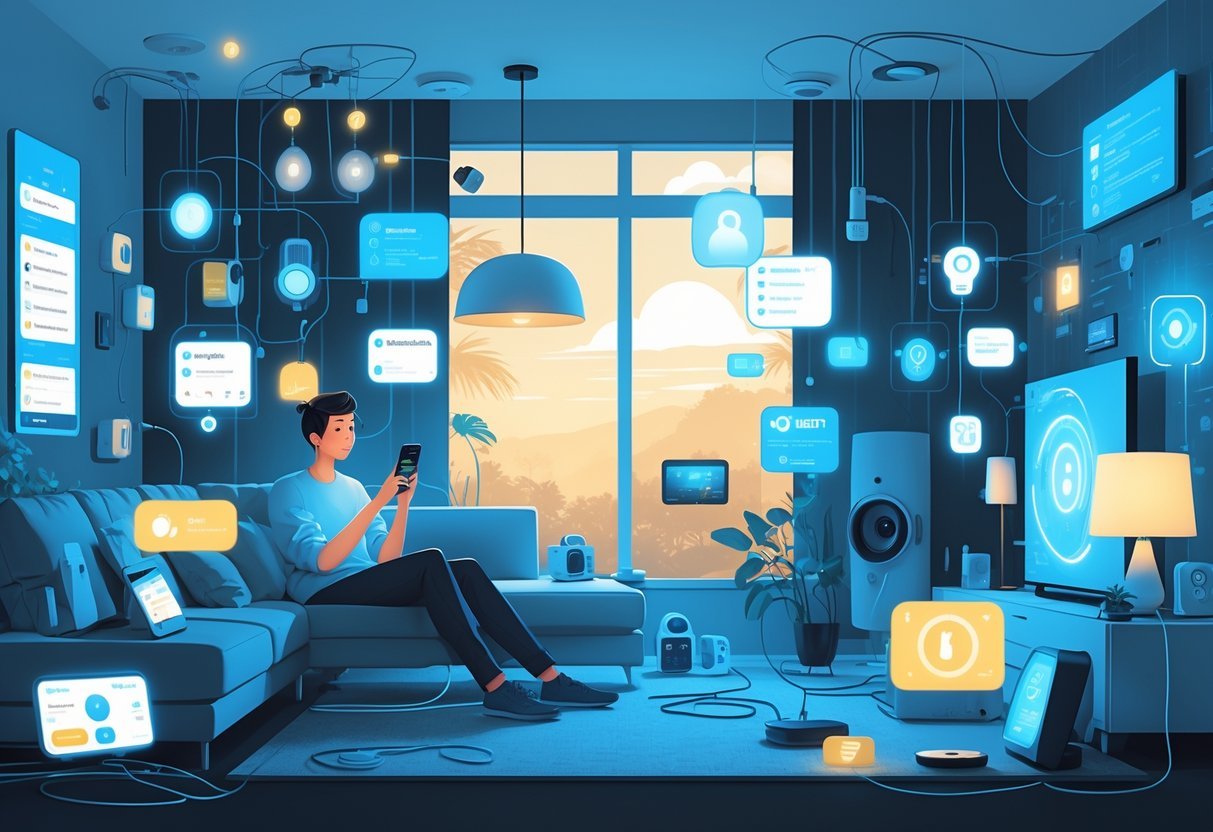
When devices clash, routines pile up, or you’re drowning in apps, smart home overkill turns into more hassle than help. Some planning and the right strategies will keep things manageable and make daily life smoother.
How can I reduce the number of conflicting automations in my smart home setup?
Go through each automation and look for overlaps. Limit routines to one goal per trigger so things don’t work against each other.
Use schedules or conditions—like time of day or motion sensors—to fine-tune routines. Stick to a single automation platform if you can.
If you’re stuck with more than one, check their logs or histories to spot and fix conflicts fast.
What steps should I take to manage tech maintenance and avoid smart home device overload?
It’s easier to keep up with maintenance when you group devices by type or brand. Set reminders for updates and battery swaps so nothing dies on you unexpectedly.
Spread devices over different outlets to avoid power problems. Review firmware update settings and try to do maintenance when you don’t need the devices running.
For more on avoiding overload and power messes, check out this rundown of common smart home problems.
Can I use a single app to control all my smart home devices and avoid app fatigue?
Absolutely—most smart home ecosystems let you control everything from one app. Amazon Alexa, Google Home, or Apple HomeKit are all solid picks.
Just make sure your devices are compatible with the same platform. That way, they’ll work together and you won’t have to keep switching apps.
If you’re just starting out, look for gadgets labeled “Works With” your chosen system.
What is the best way to deal with voice assistant conflicts in a smart home environment?
Stick with one main assistant—Alexa or Google, for example—and only connect devices that work with it.
If you can’t avoid having more than one, assign them to different rooms or uses so they don’t talk over each other. Give your devices unique names so commands don’t get mixed up.
Mute or turn off any extra assistants if they’re causing trouble nearby.
How do I prevent smart home devices from performing actions erroneously, like vacuuming during important calls?
Set schedules so devices only run during quiet times or when you’re out. Don’t make triggers too sensitive to movement or noise.
Add manual overrides or quick-access buttons so you can pause automations with a tap. Some devices have a “do not disturb” mode for meetings or special events.
Routine failures are a clear sign of smart home overkill—this guide on frequent issues with automation explores them further.
What strategies can I implement to ensure my smart home automation truly simplifies my life?
Start by looking at your daily routines and real needs—not just what’s technically possible. Honestly, if an automation sounds cool but doesn’t actually help, maybe skip it. Try out your setups a few times; sometimes they work better on paper than in real life.
Keep it simple: don’t overload yourself with tons of routines or apps, and make sure every device has a label you’ll remember. If something’s annoying or just not working, it’s totally fine to delete it.
And hey, always have a backup for the important stuff—like lights or locks—just in case the tech decides to take a day off and you need to step in.
You might also like to read:
Top 10 Must-Have Smart Home Gadgets in 2025 for Beginners: Essential Devices and Easy Upgrades










